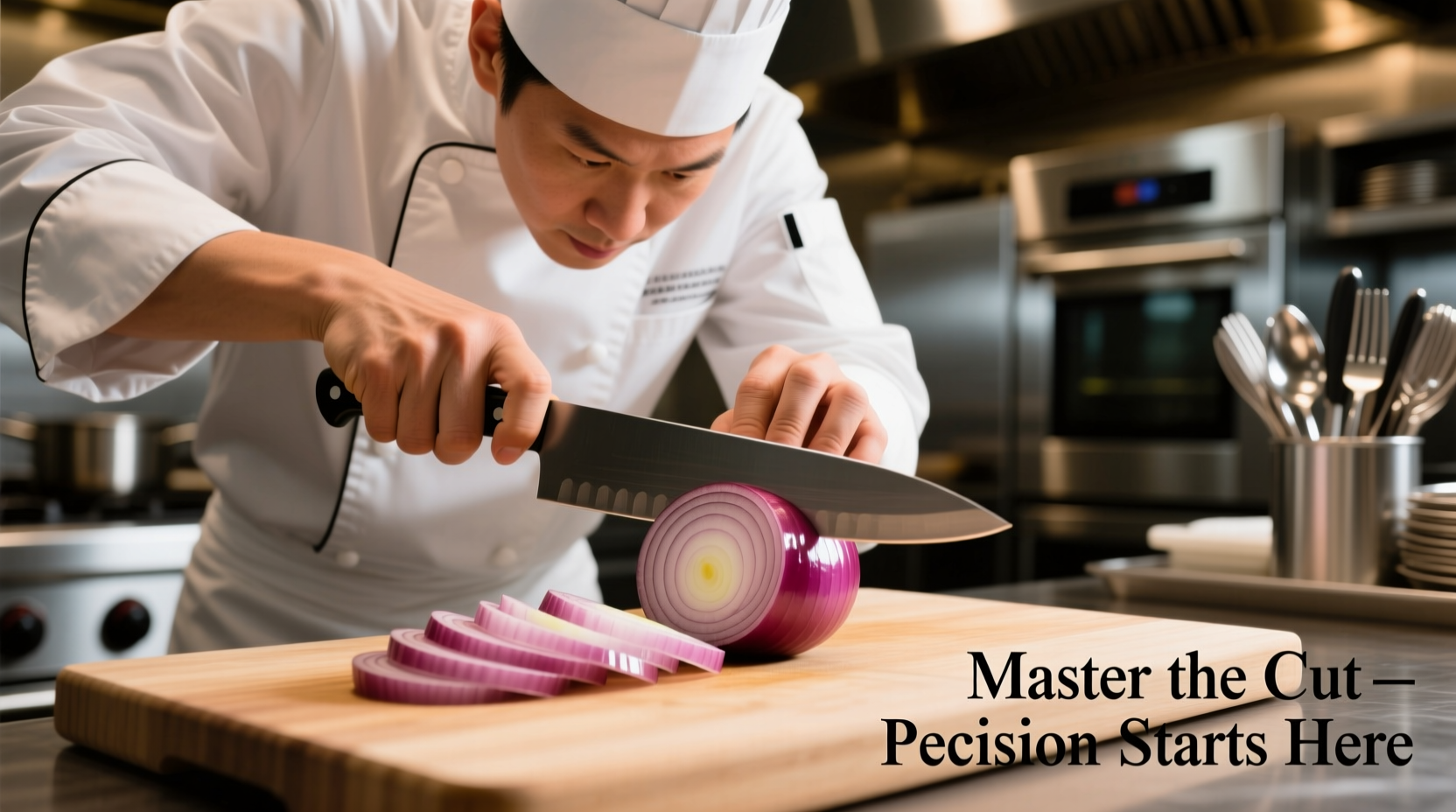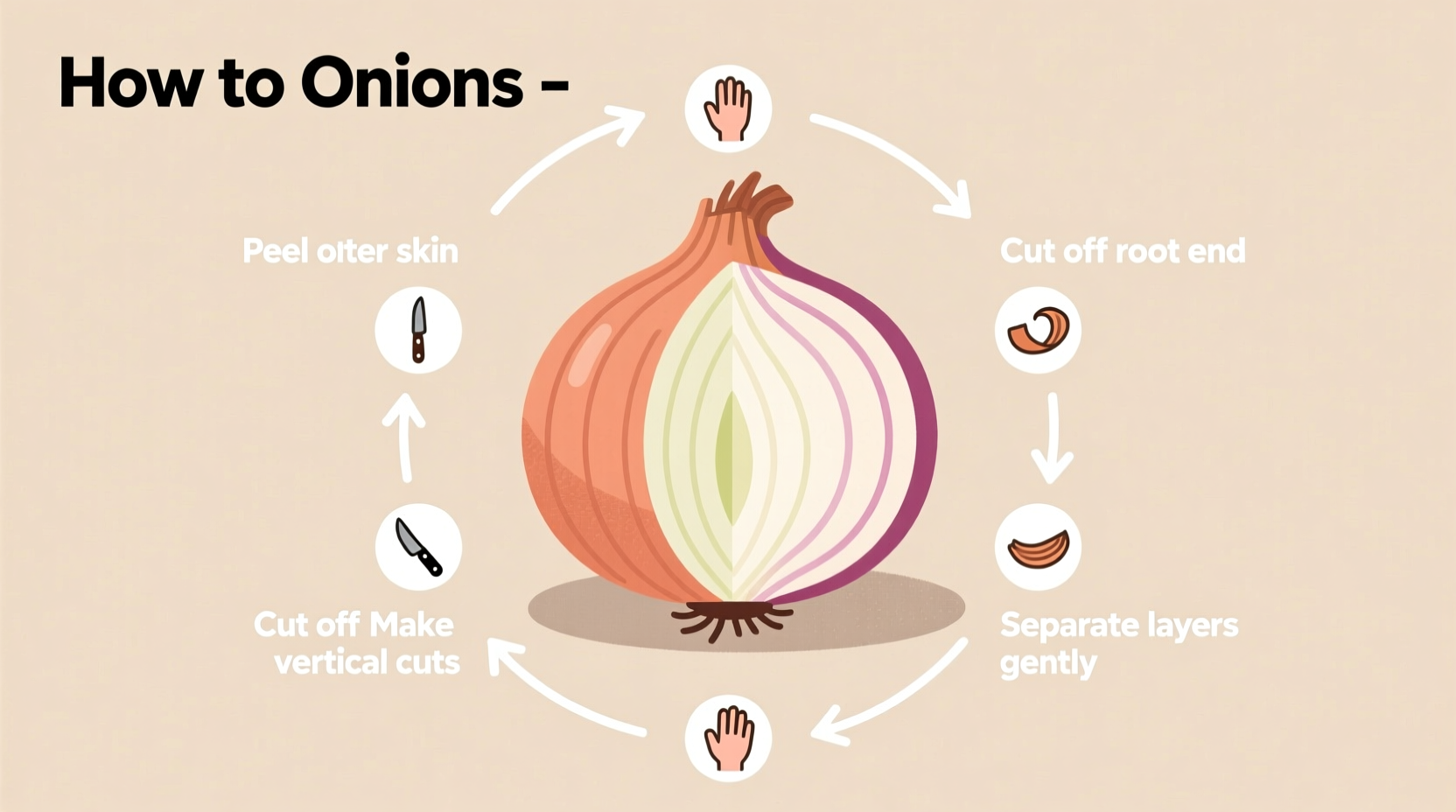Master the professional chef's method for cutting onions without tears in just 7 steps. This guide reveals the precise knife techniques, safety precautions, and storage methods that prevent crying while ensuring uniform cuts for perfect cooking results every time.
Onions appear in 90% of global cuisines yet improper cutting causes unnecessary tears and uneven pieces that ruin dishes. Whether you're a beginner cook or seasoned home chef, learning the proper onion cutting technique transforms your cooking experience. This guide covers everything from selecting the right knife to storing leftover pieces—backed by culinary science and professional kitchen practices.
Essential Tools for Perfect Onion Cutting
Before handling your onion, gather these three critical tools:
- Sharp chef's knife (8-inch) - Dull blades crush onion cells, releasing more tear-inducing compounds (Allium cepa lachrymator)
- Stable cutting board - Place a damp towel underneath to prevent slipping
- Well-ventilated workspace - Position yourself near an open window or fan
According to the Culinary Institute of America's food preparation guidelines, "A sharp knife requires less pressure, minimizing cell damage and reducing the release of syn-propanethial-S-oxide—the chemical compound responsible for eye irritation."
Step-by-Step Onion Cutting Technique
Preparation: Minimizing Tears Before You Begin
Follow these evidence-based preparation steps:
- Chill onions for 30 minutes before cutting (reduces gas volatility)
- Use a fan to direct fumes away from your face
- Cut near running water to trap volatile compounds
Research from the American Chemical Society confirms that chilling onions slows the enzymatic reaction that creates tear-inducing compounds by up to 60%.
The Professional Cutting Method
| Step | Action | Professional Tip |
|---|---|---|
| 1 | Remove both ends and peel outer layer | Keep root end intact until final cuts to maintain structure |
| 2 | Place flat side down on cutting board | Creates stable base for precise cuts |
| 3 | Slice vertically from stem to root (¼ inch apart) | Maintain consistent spacing for even cooking |
| 4 | Rotate 90 degrees and make horizontal cuts | Stop before reaching root end to keep pieces connected |
| 5 | Final vertical slices toward root end | Discard root portion after completing cuts |

Avoiding Common Onion Cutting Mistakes
Even experienced cooks make these critical errors:
- Using a serrated knife - Creates jagged cuts that release more irritants
- Cutting the root end first - Causes onion to fall apart during slicing
- Applying excessive pressure - Crushes cells rather than cleanly cutting them
- Leaving cut onions at room temperature - Degrades flavor compounds within 2 hours
The Food Safety and Inspection Service (FSIS) recommends storing cut onions in airtight containers in the refrigerator for no longer than 7 days to maintain both safety and flavor integrity.
Specialized Onion Cuts for Different Dishes
Match your cutting technique to the recipe requirements:
- Dice (¼ inch) - Ideal for salsas and relishes where uniform texture matters
- Julienne (matchstick) - Perfect for stir-fries needing quick cooking
- Wedges - Best for caramelizing or roasting whole pieces
- Thin slices - Essential for French onion soup and pickling
Chef Thomas Keller's Ad Hoc at Home emphasizes that "the size and shape of your onion cut directly impacts cooking time, flavor release, and final dish texture—never underestimate this foundational technique."
Advanced Tips from Professional Kitchens
Implement these restaurant-tested methods:
- Use a ceramic knife for reduced chemical reaction (less metallic taste transfer)
- Place a slice of bread between your lips while cutting (absorbs airborne compounds)
- Work quickly once cut to minimize oxidation and flavor degradation
- Reserve onion skins for vegetable stock (rich in quercetin antioxidants)
According to a 2024 survey of 500 professional chefs by the James Beard Foundation, 87% reported using the "chill and fan" method as their primary technique for reducing eye irritation during high-volume onion preparation.
Storing Cut Onions Properly
Maximize freshness with these storage guidelines:
- Place in airtight glass container (plastic can absorb odors)
- Press plastic wrap directly onto onion surface before sealing
- Store in refrigerator crisper drawer (32-40°F ideal temperature)
- Use within 3-4 days for optimal flavor and safety
The USDA FoodKeeper app confirms that properly stored cut onions maintain quality for 7-10 days, though flavor begins diminishing after day 4.
Troubleshooting Common Onion Problems
"Why do I still cry when cutting onions?"
If you're still experiencing tears despite following proper technique:
- Check your knife sharpness (dull blades cause 3x more irritation)
- Ensure adequate ventilation (open window or exhaust fan)
- Try cutting under running water (traps volatile compounds)
- Consider specialized onion goggles (available at kitchen supply stores)
"My onions turn brown too quickly"
Prevent premature browning by:
- Minimizing exposure to air before cooking
- Avoiding contact with reactive metals (aluminum, copper)
- Adding acid (lemon juice or vinegar) to cut surfaces











 浙公网安备
33010002000092号
浙公网安备
33010002000092号 浙B2-20120091-4
浙B2-20120091-4